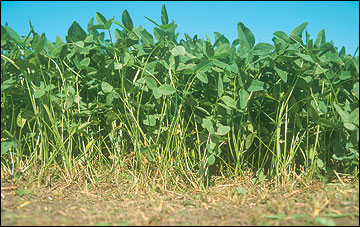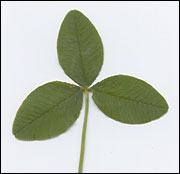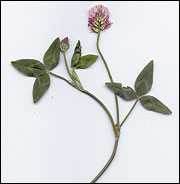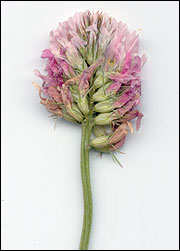Kura clover (Trifolium ambiguum Bieb.)
Legumes
Kura clover originates from the Caucasian region of Russia. It is one of the most persistent clovers and tolerates severe continuous grazing. Kura clover persists well because it has an extensive root and rhizome system. Initial regrowth in the spring consists of an upright stem containing a large white-pink flower. After defoliation, all regrowth consists of leaves and petioles that originate from crowns. In trials in northern Missouri, kura clover has yielded more than 10,000 lb/acre annually once established. The forage is succulent and rivals alfalfa in feed quality. The biggest drawback to kura clover is its poor seedling vigor. With little or no production possible in the first 18 to 24 months after seeding, it is one of the slowest legumes to establish.
 Kura clover
Kura clover
 Yield distribution of kura clover in Missouri.
Yield distribution of kura clover in Missouri.
- Origin: Russia
- Adaptation to Missouri: Best suited to northern Missouri
- Growth habit: Rhizomatous, semi-erect to prostrate perennial.
- Leaf: Palmately trifoliolate, glabrous, leaflets are lanceolate to ovate with toothed margins, glaucous undersides and often have white V-shaped markings, petioles glabrous to slightly pubescent.
- Stems: Glabrous, short, prostrate to semi-erect stems, branch from crown.
- Stipules: Membranous stipules with distinct veins.
- Flowers: Large, white or pink, inflorescences have up to 175 white florets.
- Fertilization: No N needed if nodulated. Maintain 30 lb/acre P and 250 lb/acre K.
- Timing of production: 60 percent of annual production between April 1 and June 30.
- When to begin grazing: Often based on the height of the grass in the mixture. Pure stands may be grazed when the clover reaches 8 inches in height.
- When to cut for hay: Not normally cut for hay unless it is mixed with a companion grass. Harvest based on the maturity of the grass.
- Lowest cutting or grazing height: 3 inches
- Fall management: Avoid severe grazing from Sept. 15 until the first hard killing frost.


